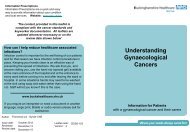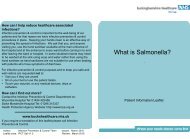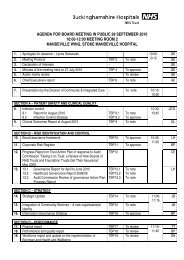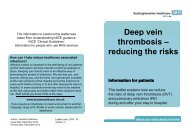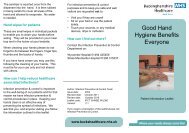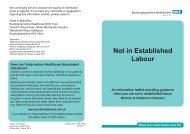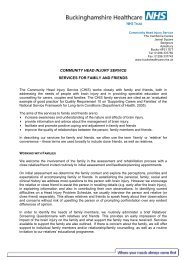Induction of Labour (with intact membranes)
Induction of Labour (with intact membranes)
Induction of Labour (with intact membranes)
Create successful ePaper yourself
Turn your PDF publications into a flip-book with our unique Google optimized e-Paper software.
If there is anything you would like more information on, or don’tunderstand, please ask your midwife or obstetrician who willanswer any questions you might have at any stage.Women & Children’s DirectorateWe continually strive to improve the quality <strong>of</strong> information given topatients. If you have any comments or suggestions regarding thisinformation booklet, please contact:Head <strong>of</strong> Midwifery, Women & Children’s Directorate BuckinghamshireHealthcare NHS TrustStoke Mandeville HospitalMandeville Road, Aylesbury, Buckinghamshire, HP21 8ALApprovals: Maternity Guidelines Group: V1 Nov 2010. V2 July 2012Divisional Board: V1 Mar 2011. V2 Sep 2012Clinical Guidelines Subgroup: V1 Apr 2011. V2 4.10.12MSLC: V1 Jan 2011. V2 July 2012Equality Impact Assessment: V1 Dec 2010. V2 Dec 2012Patient Experience Group: V2 Aug 2011.How can I help reduce Healthcare AssociatedInfections?Infection control is important to the wellbeing <strong>of</strong> our patients,and for that reason we have infection control procedures inplace.Keeping your hands clean is an effective way <strong>of</strong> preventingthe spread <strong>of</strong> infections. We ask that you, and anyonevisiting you, use the hand rub (special gel) available at themain entrance <strong>of</strong> the hospital and at the entrance to everyward before coming into and after leaving the ward orhospital. In some situations hands may need to be washedat a sink using soap and water rather than using the handrub. Staff will let you know if this is the case.www.buckshealthcare.nhs.ukIf you require an interpretation <strong>of</strong> this leaflet please contactyour midwife or doctor<strong>Induction</strong> <strong>of</strong> <strong>Labour</strong>(<strong>with</strong> <strong>intact</strong> <strong>membranes</strong>)Information for pregnant women their partners andtheir familiesThis leaflet has been written to help you and your partnerunderstand what might happen during an induction <strong>of</strong> labour.Author: G SuriIssue date: March 2013Review date: March 2016Leaflet code: WZZ1387Version: 2Where your needs always come first
What is induction <strong>of</strong> labour?Most women will start labour spontaneously by 42 weeks <strong>of</strong> pregnancy.<strong>Induction</strong> <strong>of</strong> labour is the process designed to start labour artificially. Onaverage approximately 1 in 5 labours are induced. There are a number<strong>of</strong> reasons why induction may be <strong>of</strong>fered and recommended. Forexample, if you have a medical condition in pregnancy such as diabetesor high blood pressure (pre-eclampsia) and there comes a time when itis clinically indicated that giving birth would benefit the health <strong>of</strong> you oryour baby. The most common reason for induction <strong>of</strong> labour is to avoidthe risks associated <strong>with</strong> a prolonged pregnancy (a pregnancy lastinglonger than 42 weeks).How your body prepares to give birthDuring pregnancy your baby is surrounded by amniotic fluid, <strong>of</strong>ten calledthe ‘waters’ and these are contained <strong>with</strong>in the <strong>membranes</strong> (the sac)which <strong>of</strong>fers protection to your baby whilst developing in the womb(uterus).In preparation for labour the neck <strong>of</strong> the womb s<strong>of</strong>tens and shortens.This is sometimes referred to as ‘ripening <strong>of</strong> the cervix’ and cansometimes take a few days to occur.Before or during labour the <strong>membranes</strong> break (rupture) releasing thefluid. This is <strong>of</strong>ten referred to as your ‘waters breaking’.The process <strong>of</strong> labour involves the cervix opening (dilating) and theuterus contracting to push your baby out.When is induction recommended?At the 38 week antenatal visit your midwife or obstetrician should <strong>of</strong>fer todiscuss the induction process <strong>with</strong> you and the clinical indications forinduction (eg avoiding a prolonged pregnancy). They should talk to youabout the risks and benefits <strong>of</strong> induction, explain the alternatives andadvise you about further sources <strong>of</strong> information. This gives you plenty <strong>of</strong>time to discuss induction <strong>with</strong> those close to you and ask any questionsbefore the possibility <strong>of</strong> induction <strong>of</strong> labour is recommended.If you have had a healthy uncomplicated pregnancy, induction <strong>of</strong> labourwill be <strong>of</strong>fered at 40 weeks plus 12 days in order to give you time in yourpregnancy to start labour naturally.<strong>membranes</strong>. If it is possible to rupture the <strong>membranes</strong> you will betaken to the <strong>Labour</strong> Ward as soon as they are able to accept you. If<strong>Labour</strong> Ward is very busy and are unable to accept you at that time,you should be aware that the next step <strong>of</strong> your induction processcould be delayed for a few hours or even until the next day. We willkeep you informed <strong>of</strong> events at all times. Once the induction processhas started we would advise you to remain in hospital until you havedelivered your baby. During this time we will continue to monitor youand your baby regularly.• Women having their first baby are advised to start intravenousoxytocin immediately after your <strong>membranes</strong> have been ruptured. Ifyou have had a baby before, you could wait up to 2 more hoursbefore starting oxytocin.• It is important that you are fully aware that not every woman givesbirth on the day <strong>of</strong> their induction (particularly first time mothers).<strong>Induction</strong> <strong>of</strong> labour can take a few days. We would advise you tobring books, magazines etc to keep you occupied.Further Information: For further information about induction <strong>of</strong>labour and all other aspects <strong>of</strong> pregnancy and childbirth talk toyour midwife or doctor.Antenatal Clinic on: 01296 316140 01494 425569(Stoke)(Wycombe)<strong>Labour</strong> Ward on: 01296 316103/4(Stoke)• MIDIRS Informed Choice leaflets can be found atwww.infochoice.org. These are downloadable information leaflets onmany aspects <strong>of</strong> labour and birth, including induction.• Royal College <strong>of</strong> Obstetricians and Gynaecologists website atwww.rcog.org.uk/resources/public/pdf/rcog induction_<strong>of</strong>_labour.pdfhas the full induction <strong>of</strong> labour guideline including sources <strong>of</strong>evidence.• NICE website at www.nice.org.uk/page.aspx?o=17330 has the fullpatient information leaflet.2 7Where your needs always come first
Steps in the induction process• The reason(s) for inducing your labour will have been discussed <strong>with</strong>you and, <strong>with</strong> your agreement, a date for induction will be given toyou.• If it is your first baby you will be admitted at 0800hrs and if it is asecond or subsequent pregnancy you are admitted at 1100hrs.• You will be welcomed by the ward staff and shown to your bed. Onceyou have settled in, the facilities <strong>of</strong> the ward will be shown to you andyou will be given any other information that is relevant to your stay inhospital. The midwife will monitor your baby’s heartbeat for 30minutes and record other observations, e.g. blood pressure,temperature and pulse rate. You will be seen by a member <strong>of</strong> thematernity team and the type <strong>of</strong> induction that is suitable for you willbe confirmed. This is a good time to ask any questions you or yourpartner may have.• Women who are having their first baby. An internal examinationwill be performed <strong>with</strong> your consent. If you require prostaglandins apessary (Propess®) will be inserted into the vagina. This will stay infor 24 hours and be removed the following morning (sooner if you gointo labour before then). This will take place on the Antenatal Wardunless you have been told you will need to have Propess® on the<strong>Labour</strong> Ward.• Women who have had a baby before. An internal examination willbe performed <strong>with</strong> your consent and, if needed, a Prostin® tablet willbe inserted into the vagina. This will usually take place on theAntenatal Ward. After approximately 6 hours you will be assessedagain including an internal examination and, if needed, a secondProstin® tablet may be given.• You will be encouraged to sleep overnight and will need to stay inhospital. If you are not in active labour at the end <strong>of</strong> visiting hoursyour partner will be asked to go home and will be telephoned whenyou start to go into established labour. This enables you both to rest.• If you have not already gone into labour, then 6 hours after your lastProstin® tablet or when the Propess® pessary is removed, you willbe examined to determine if it is possible to rupture yourIf your pregnancy is more than 41 weeks<strong>Induction</strong> <strong>of</strong> labour is recommended from 40 weeks plus 12 daysbecause the risk <strong>of</strong> your baby developing health problems begins toincrease from 42 weeks. The risk <strong>of</strong> stillbirth is 3 babies in every 3000births after 42 weeks compared to 1 in 3000 at 37 weeks. If you choosenot to be induced at this stage, you and your obstetrician will make aplan <strong>of</strong> care from 42 weeks which at a minimum will include:• Twice weekly checks <strong>of</strong> your baby’s heartbeat using a piece <strong>of</strong>equipment called an electronic fetal heart rate monitor orcardiotocograph (CTG).• An ultrasound scan to check the amount <strong>of</strong> water (amniotic fluid)surrounding your baby.An induction because you are overdue does not increase thechance <strong>of</strong> you needing a Caesarean section.Membrane SweepingBefore you are <strong>of</strong>fered an induction you should be <strong>of</strong>fered a <strong>membranes</strong>weep. This has been shown to increase your chance <strong>of</strong> starting labournaturally <strong>with</strong>in 48 hours and can reduce the need for other methods <strong>of</strong>induction <strong>of</strong> labour.Membrane sweeping involves a vaginal examination during which yourmidwife or doctor will place a gloved finger just inside your cervix andmake a circular, sweeping movement to separate the <strong>membranes</strong> fromthe cervix. It can be carried out at home, at an outpatient appointment orin hospital.Membrane sweeping may cause some discomfort or light bleeding butwill not cause any harm to your baby. You should be <strong>of</strong>fered amembrane sweep at your 40 and 41 week antenatal appointmentsduring your first pregnancy or your 41 week antenatal appointment if youhave had a baby before. Membrane sweeps should not be performed ifyour waters have broken.How is labour induced?There are a variety <strong>of</strong> methods that can be used to induce labour. Youmay be <strong>of</strong>fered one or all <strong>of</strong> the methods described, depending on yourindividual circumstances. Once started, the induction process continuesuntil your baby is born.Where your needs always come first6 3
ProstaglandinsProstaglandins are drugs that act like natural hormones to start labour.They are either given as a tablet known as Prostin® (dinoprostone 3 mg)or as a pessary known as Propess® (dinoprostone 10 mg), either <strong>of</strong>which is inserted into the vagina. This is undertaken in hospital on theantenatal ward or labour ward depending on the reason for yourinduction.Before being given any prostaglandins your baby’s heartbeat will bechecked for approximately 20-30 minutes using a cardiotocographmonitor (CTG). This will be repeated after the prostaglandin medicationhas been given. We will also monitor your baby’s heartbeat oncecontractions start.First time mothers are given the Propess® vaginal pessary which willstay in place for 24 hours. It is removed if active labour starts.If you have had a baby before, you will be given a Prostin® vaginaltablet. However, more than one dose may be needed to induce yourlabour. A second dose <strong>of</strong> the Prostin® tablet can be given 6-8 hourslater if needed.Induced labours may be more painful than spontaneous labour andoccasionally Prostin® can cause vaginal soreness. Pain managementoptions will be discussed <strong>with</strong> you at your antenatal appointment and youwill be supported <strong>with</strong> your pain management choices in labour.Very occasionally prostaglandins can cause the uterus to contract toomuch which may affect the pattern <strong>of</strong> your baby’s heartbeat. If thishappens you will be asked to lie on your left side. You may be givenother medication to help relax the uterus and any tablet/pessaryremaining in your vagina will be removed.The aim <strong>of</strong> the prostaglandins is to either start your labour or to dilate thecervix enough that the <strong>membranes</strong> can be artificially ruptured (the watersbroken). Occasionally, despite being given two Prostin® tablets or aPropess® pessary, the cervix does not dilate sufficiently to be able torupture the <strong>membranes</strong>. In this circumstance the obstetrician willdiscuss the options <strong>with</strong> you. This may include <strong>of</strong>fering you anotherdose <strong>of</strong> prostaglandins.Artificial rupture <strong>of</strong> the <strong>membranes</strong> (ARM) or amniotomy(breaking <strong>of</strong> the waters)If your waters have not broken a procedure called an amniotomy(ARM) will be recommended. This is when your midwife or doctormakes a hole in the membrane to release (break) the waters.This procedure is performed during a vaginal examination using asmall plastic disposable instrument. This will cause no harm to youor your baby, but the vaginal examination needed to perform thisprocedure may cause you some discomfort. This procedure isperformed on the labour ward.Oxytocin Intravenous Infusion (hormone drip)If active labour does not start following the rupture <strong>of</strong> <strong>membranes</strong> adrip containing synthetic oxytocin will be given to you through aplastic tube inserted into a vein. Oxytocin in this form is a drug thatmimics the natural hormones that cause contractions and thereforestart labour.The amount <strong>of</strong> synthetic oxytocin you receive will be increased toensure you are contracting regularly (approximately 3-4 contractionsin 10 minutes). If you start to contract too much the infusion rate canbe reduced.Whilst being given intravenous oxytocin your baby’s heartbeat will bemonitored continuously by a CTG. The oxytocin drip can limit yourability to move around. Whilst it may be okay to stand up or sit down,it will not be possible to have a bath or move from room to room.Women who have intravenous oxytocin are more likely to ask for anepidural in labour. An epidural is a form <strong>of</strong> pain relief provided by ananaesthetist (please discuss <strong>with</strong> your midwife if you need moreinformation related to epidurals).Where your needs always come first4 5




